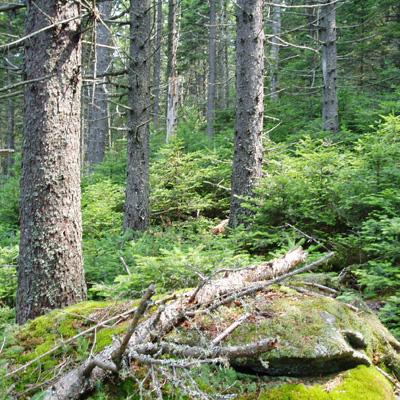Carbon Stocks in Northern Old Growth Forests

Forest carbon offsets are an increasingly popular climate change mitigation option. Recent policy developments, such as the Regional Greenhouse Gas Initiative and the Montreal Process Criteria and Indicators of Sustainable Forestry, have prompted much discussion about managing for carbon storage as an additional value of forests. Yet, many basic questions remain, particularly related to soils and how forest type affects the amount of carbon stored in soil.
To establish benchmark data, NSRC researchers estimated carbon stocks in surface mineral soil (0-20 cm), forest floor, down dead wood, standing dead, and aboveground live biomass pools in old-growth hardwood and softwood forests in Maine, New Hampshire, and Vermont. Hardwood stands were northern hardwoods; softwood stands were spruce-fir, spruce-hemlock, or hemlock. Researchers inventoried 24 plots (four hardwood and four softwood sites per state).
Carbon stock estimates were fairly consistent within forest type. In hardwood forests, carbon in aboveground live biomass ranged from 94 tons/hectare in New Hampshire to 139 tons/hectare in Vermont, while estimated total stocks for all carbon pools measured were 214-218 tons/hectare. In softwood stands, carbon in aboveground biomass varied from 111 tons/hectare in Vermont to 143 tons/hectare in Maine. Total carbon was significantly higher in softwood stands than in hardwood stands in all states and ranged from 234 to 292 tons/hectare. Down dead wood was a small carbon pool, averaging less than 8% of total stocks. Mineral soil carbon averaged 63-72 tons/hectare, with no consistent differences between hardwood and softwood stands. However, carbon stored in softwood forest floors was over three times that in hardwood forest floors, especially beneath hemlock.
Download printable version [PDF]
Download full final report [PDF]
